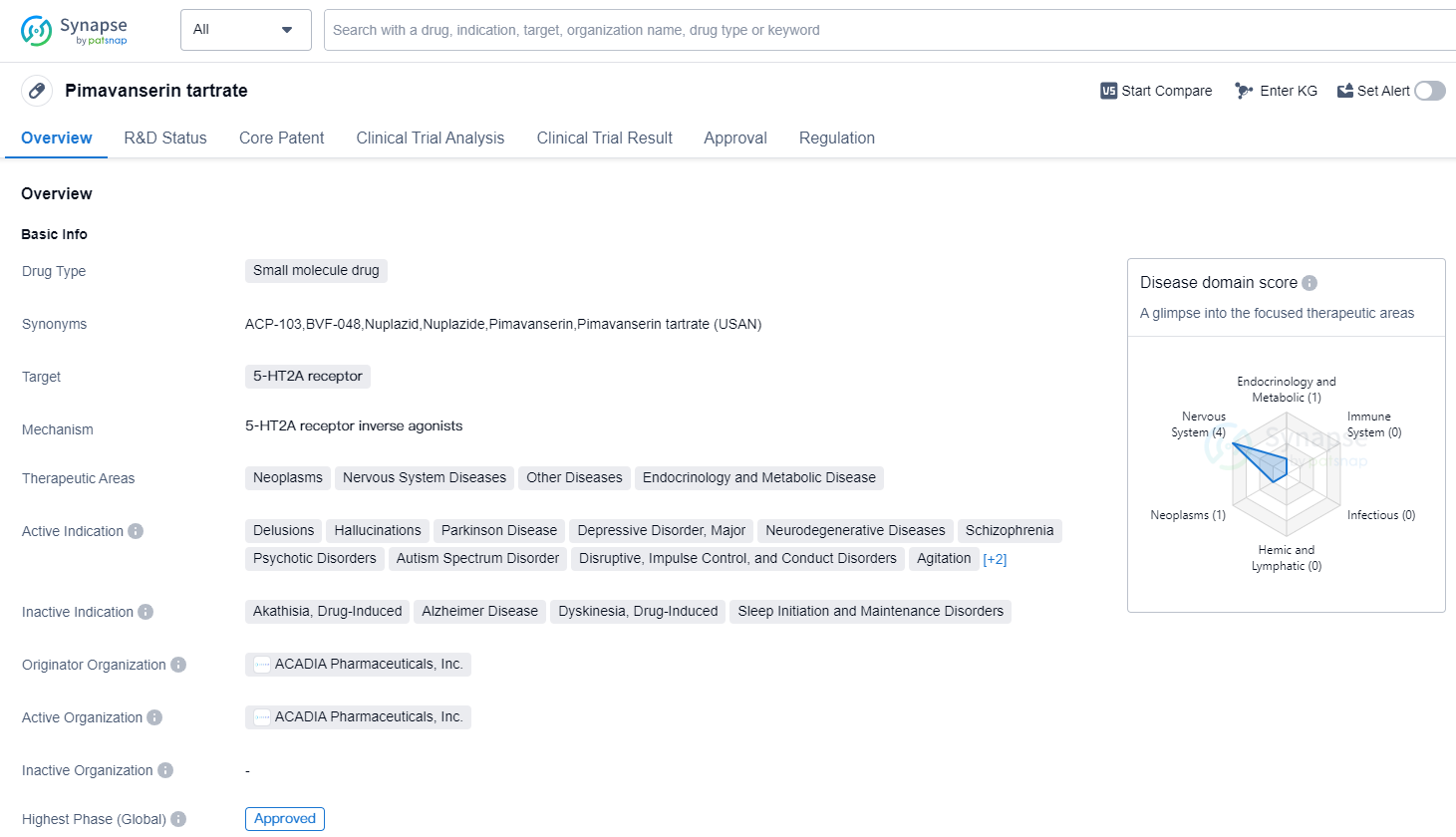Pharmaceutical Insights: pimavanserin tartrate's R&D Progress and its Mechanism of Action on Drug Target
Pimavanserin tartrate's R&D Progress
Pimavanserin tartrate is a small molecule drug that targets the 5-HT2A receptor. It has been approved for use in various therapeutic areas including neoplasms, nervous system diseases, other diseases, endocrinology, and metabolic diseases. The drug has shown efficacy in treating several indications such as delusions, hallucinations, Parkinson's disease, major depressive disorder, neurodegenerative diseases, schizophrenia, psychotic disorders, autism spectrum disorder, disruptive, impulse control, and conduct disorders, agitation, behavioral disorders, and glioblastoma.
The drug was developed by ACADIA Pharmaceuticals, Inc., an originator organization in the pharmaceutical industry. It received its first approval in the United States in April 2016. Pimavanserin tartrate has been classified as a breakthrough therapy, indicating its potential to provide significant benefits over existing treatments for certain conditions.
Pimavanserin tartrate's approval and therapeutic areas suggest its potential in addressing a wide range of diseases and disorders. Its targeting of the 5-HT2A receptor indicates its mechanism of action, which may involve modulating serotonin signaling pathways. This receptor is known to play a role in various neurological and psychiatric conditions, making it a promising target for drug development.
The drug's approval for indications such as Parkinson's disease, schizophrenia, and major depressive disorder highlights its potential in treating complex and debilitating conditions. Additionally, its efficacy in addressing disruptive, impulse control, and conduct disorders, as well as behavioral disorders, suggests its potential in managing behavioral symptoms associated with various neurological and psychiatric conditions.
Furthermore, pimavanserin tartrate's potential in treating neoplasms and glioblastoma indicates its potential application in the field of oncology. This suggests that the drug may have anti-cancer properties or could be used as an adjunct therapy in cancer treatment.
👇Please click on the image below to directly access the latest data (R&D Status | Core Patent | Clinical Trial | Approval status in Global countries) of this drug.
Mechanism of Action for pimavanserin tartrate: 5-HT2A receptor inverse agonists
The 5-HT2A receptor inverse agonists are a type of drugs that interact with the 5-HT2A receptors in the brain. These receptors are a subtype of serotonin receptors, which are involved in various physiological and neurological processes.
From a biomedical perspective, these drugs are used to modulate the activity of the 5-HT2A receptors. Inverse agonists have the opposite effect of agonists, which activate the receptors. Instead, inverse agonists bind to the receptors and produce a pharmacological response that is opposite to the natural activity of the receptor. In the case of 5-HT2A receptor inverse agonists, they decrease the activity of the receptor.
These drugs have been studied and used in the treatment of various conditions, including psychiatric disorders such as depression, anxiety, and schizophrenia. By reducing the activity of the 5-HT2A receptors, they can help regulate serotonin signaling in the brain, which is implicated in mood regulation and cognitive processes.
Drug Target R&D Trends for pimavanserin tartrate
The 5-HT2A receptor is a subtype of serotonin receptor found in the human body. It plays a crucial role in various physiological and neurological processes. Activation of the 5-HT2A receptor is associated with the regulation of mood, cognition, and perception. It is involved in the modulation of serotonin levels, which affects mood disorders such as depression and anxiety. Additionally, the 5-HT2A receptor is implicated in the regulation of sleep, appetite, and sexual behavior. Understanding the role of the 5-HT2A receptor has led to the development of pharmaceutical drugs targeting this receptor for the treatment of various psychiatric and neurological disorders.
According to Patsnap Synapse, as of 14 Sep 2023, there are a total of 188 5-HT2A receptor drugs worldwide, from 255 organizations, covering 155 indications, and conducting 3416 clinical trials.
The analysis of the target 5-HT2A receptor reveals a competitive landscape with several companies making significant progress in drug development. Sumitomo Chemical Co., Ltd., Novartis AG, Johnson & Johnson, Teva Pharmaceutical Industries Ltd., and Otsuka Holdings Co., Ltd. are the companies growing fastest under this target. The most common indications for drugs targeting the 5-HT2A receptor include schizophrenia, bipolar disorder, and depressive disorder. Small molecule drugs are progressing most rapidly, indicating intense competition in the market. The United States, Japan, and the European Union are leading in terms of drug development, but China is also making progress. Overall, the target 5-HT2A receptor shows promise for future development in the pharmaceutical industry.
👇Please click on the picture link below for free registration or log in directly if you have a freemium account, you can browse the latest research progress on drugs, indications, organizations, clinical trials, clinical results, and drug patents related to this target
Conclusion
Overall, pimavanserin tartrate's approval, therapeutic areas, and target receptor indicate its potential as a versatile drug in the field of biomedicine. Its breakthrough therapy designation further emphasizes its potential to address unmet medical needs and provide significant advancements in the treatment of various diseases and disorders.






